engine TOYOTA FJ CRUISER 2014 1.G Owners Manual
[x] Cancel search | Manufacturer: TOYOTA, Model Year: 2014, Model line: FJ CRUISER, Model: TOYOTA FJ CRUISER 2014 1.GPages: 572, PDF Size: 9.45 MB
Page 426 of 572
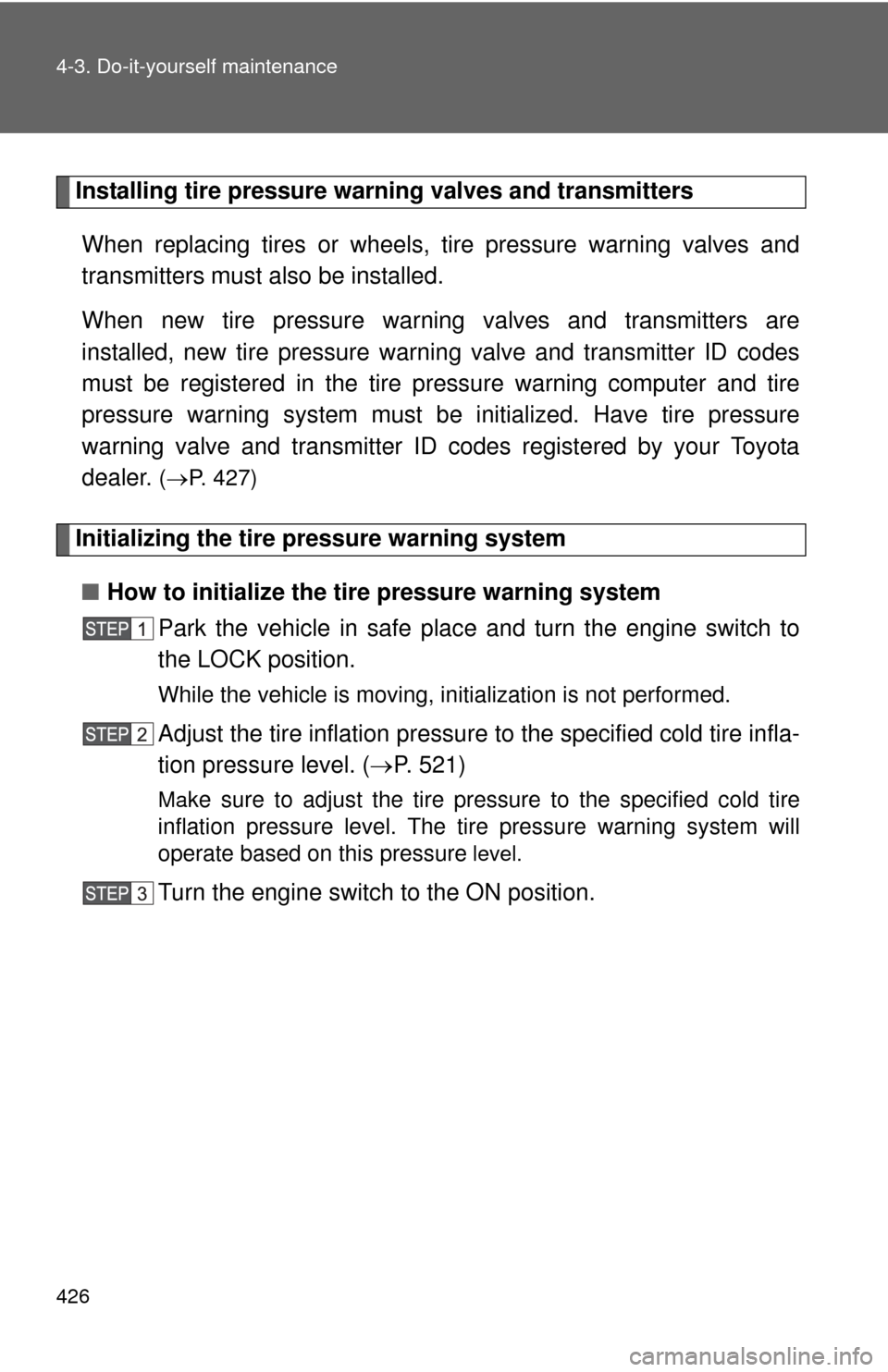
426 4-3. Do-it-yourself maintenance
Installing tire pressure warning valves and transmittersWhen replacing tires or wheels, tire pressure warning valves and
transmitters must also be installed.
When new tire pressure warning valves and transmitters are
installed, new tire pressure warn ing valve and transmitter ID codes
must be registered in the tire pr essure warning computer and tire
pressure warning system must be initialized. Have tire pressure
warning valve and transmitter ID codes registered by your Toyota
dealer.
( P. 427)
Initializing the tire pressure warning system
■ How to initialize the tire pressure warning system
Park the vehicle in safe plac e and turn the engine switch to
the LOCK position.
While the vehicle is moving, in itialization is not performed.
Adjust the tire inflation pressure to the specified cold tire infla-
tion pressure level. ( P. 521)
Make sure to adjust the tire pressure to the specified cold tire
inflation pressure level. The ti re pressure warning system will
operate based on this pressure
level.
Turn the engine switch to the ON position.
Page 427 of 572
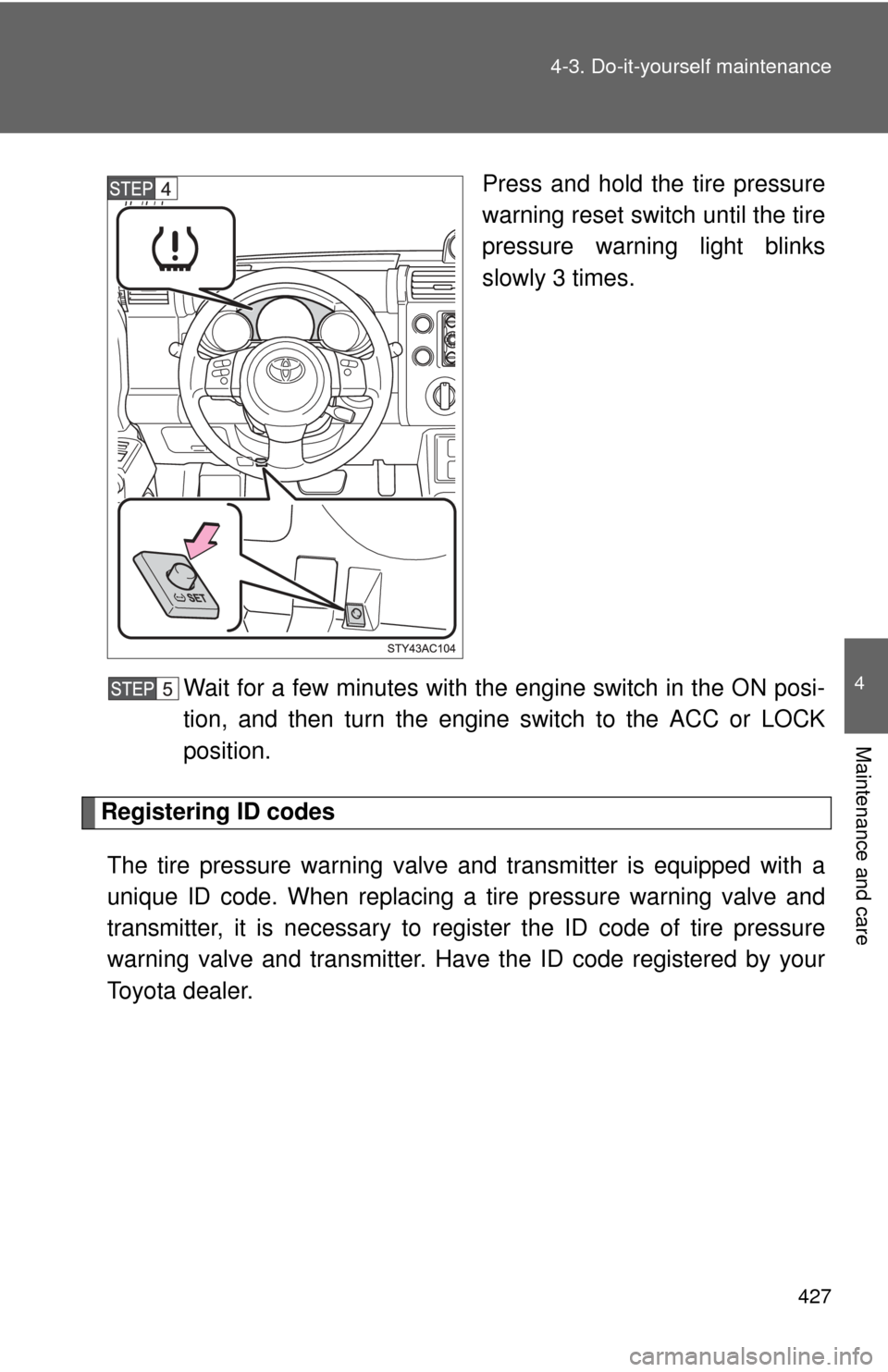
427
4-3. Do-it-yourself maintenance
4
Maintenance and care
Press and hold the tire pressure
warning reset switch until the tire
pressure warning light blinks
slowly 3 times.
Wait for a few minutes with the engine switch in the ON posi-
tion, and then turn the engine switch to the ACC or LOCK
position.
Registering ID codes The tire pressure warning valve and transmitter is equipped with a
unique ID code. When replacing a tire pressure warning valve and
transmitter, it is necessary to regi ster the ID code of tire pressure
warning valve and transmitter. Have the ID code registered by your
Toyota dealer.
Page 440 of 572
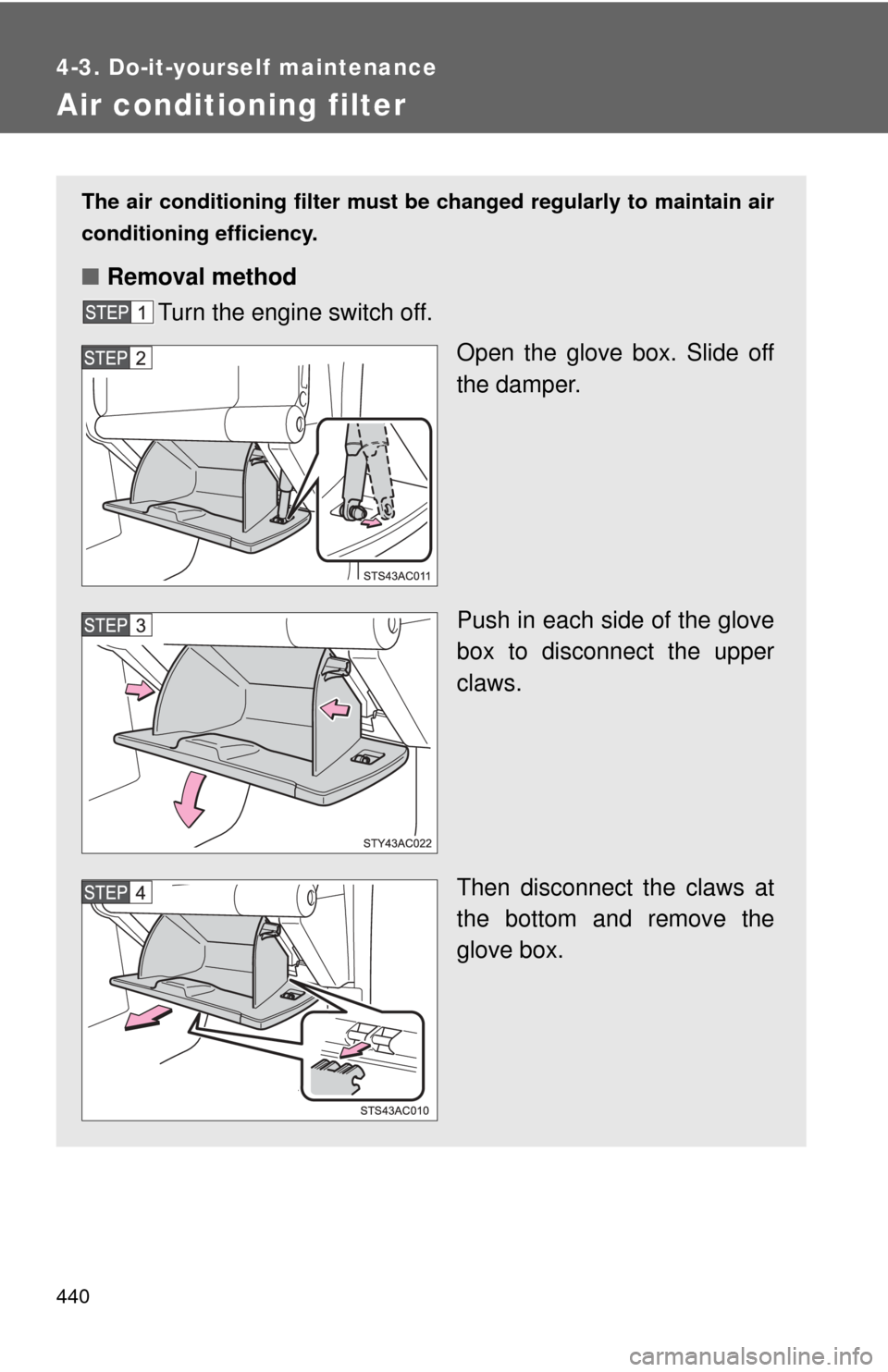
440
4-3. Do-it-yourself maintenance
Air conditioning filter
The air conditioning filter must be changed regularly to maintain air
conditioning efficiency.
■ Removal method
Turn the engine switch off.
Open the glove box. Slide off
the damper.
Push in each side of the glove
box to disconnect the upper
claws.
Then disconnect the claws at
the bottom and remove the
glove box.
Page 445 of 572

445
4-3. Do-it-yourself maintenance
4
Maintenance and care
Checking and replacing fuses
If any of the electrical components do not operate, a fuse may have
blown. If this happens, check and replace the fuses as necessary.
Turn the engine switch off.
The fuses are located in the following places. To check the
fuses, follow the in structions below.
■ Engine compartment
Ty p e A
Push the tab in and lift the lid
off.
Type B (if equipped) Push the tab in and lift the lid
off.
Page 449 of 572
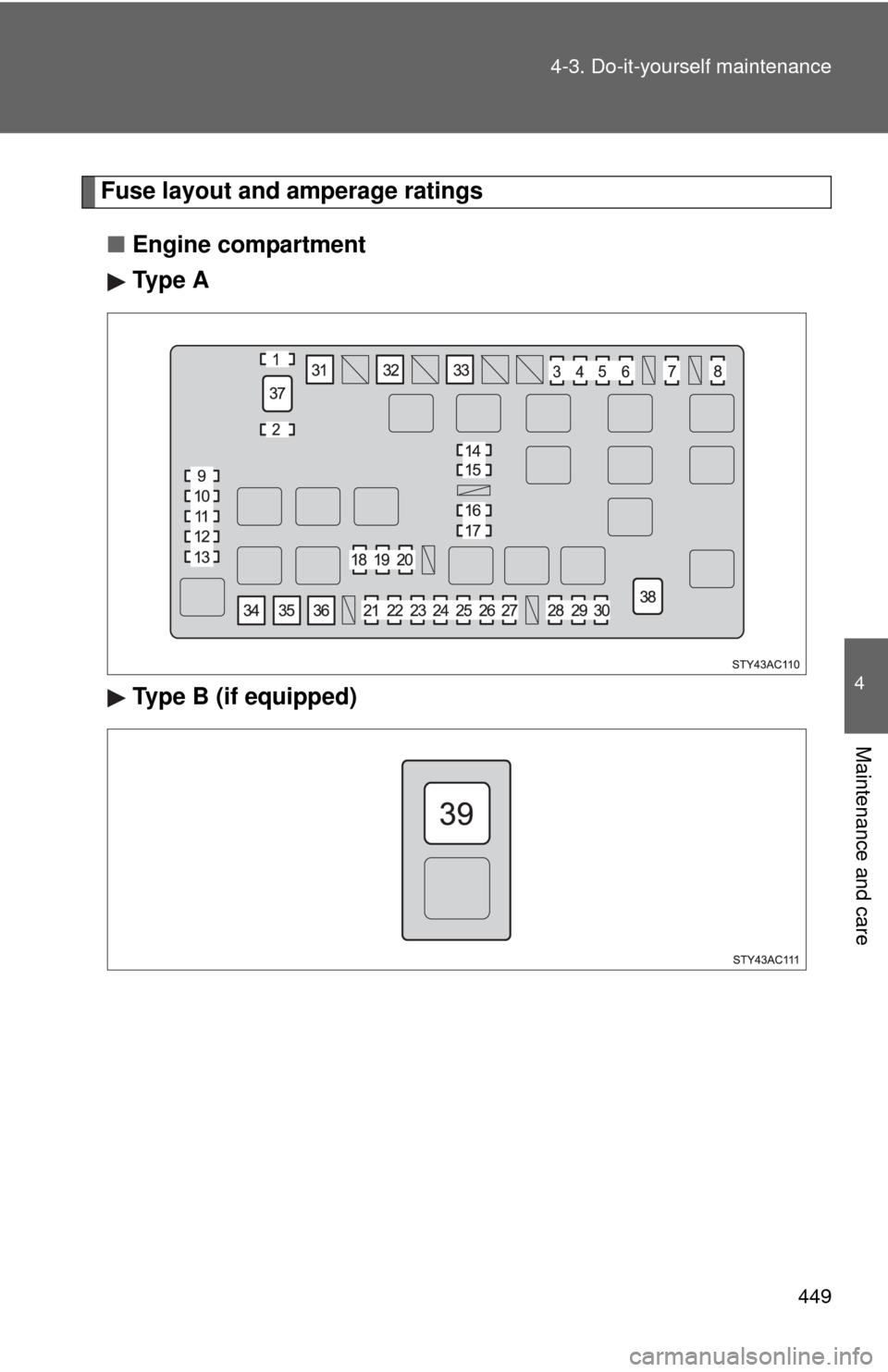
449
4-3. Do-it-yourself maintenance
4
Maintenance and care
Fuse layout and amperage ratings
■ Engine compartment
Ty p e A
Type B (if equipped)
Page 451 of 572

451
4-3. Do-it-yourself maintenance
4
Maintenance and care
18 DOME
10 AInterior light, personal lights,
engine switch light, clock, acces-
sory meter, meter and gauge
19 RADIO NO.1 20 A Audio system
20 ECU-B 10 AAir conditioning system, multiplex
communication system, SRS air-
bag system, front passenger occu-
pant classification system, garage
door opener, Crawl Control system
21 ALT-S 7.5 A Charging system
22 AI-VSV 10 A AI system
23 HORN 10 A Horn
24 A/F HEATER 15 A Multiport fuel injection system/
sequential multiport fuel injection
system
25 TRN-HAZ 15 ATurn signal lights, emergency
flashers
26 ETCS 10 AMultiport fuel injection system/
sequential multiport fuel injection
system, electronic throttle control
system
27 EFI 20 AEFI NO.2, multiport fuel injection
system/sequential multiport fuel
injection system
28 DR/LCK 20 ADoor lock system, multiplex com-
munication system
29 TOWING 15 A Towing converter
30 RADIO NO.2 20 A Audio system
31 AIR PMP 50 A AI system
32 AM1 50 AACC, ECU-IG, IG1, RR WSH, FR
WIP-WSH, 4WD/DIFF and STA
33 J/B 50 A TAIL, PWR OUTLET, POWER
FuseAmpereCircuit
Page 465 of 572

When trouble arises5
465
5-1. Essential informationEmergency flashers ......... 466
If your vehicle needs to be towed .................... 467
If you think something is wrong ......................... 472
Fuel pump shut off system ........................... 473 5-2. Steps to take
in an emergency
If a warning light turns on or a warning buzzer
sounds... ........................ 474
If you have a flat tire......... 484
If the engine will not start ................................ 497
If the shift lever cannot be shifted from P
(vehicles with
an automatic
transmission) ................. 498
If you lose your keys ........ 499
If the vehicle battery is discharged .................. 500
If your vehicle overheats ....................... 504
If the vehicle becomes stuck .............................. 507
If your vehicle has to be stopped
in an emergency ............ 509
Page 466 of 572
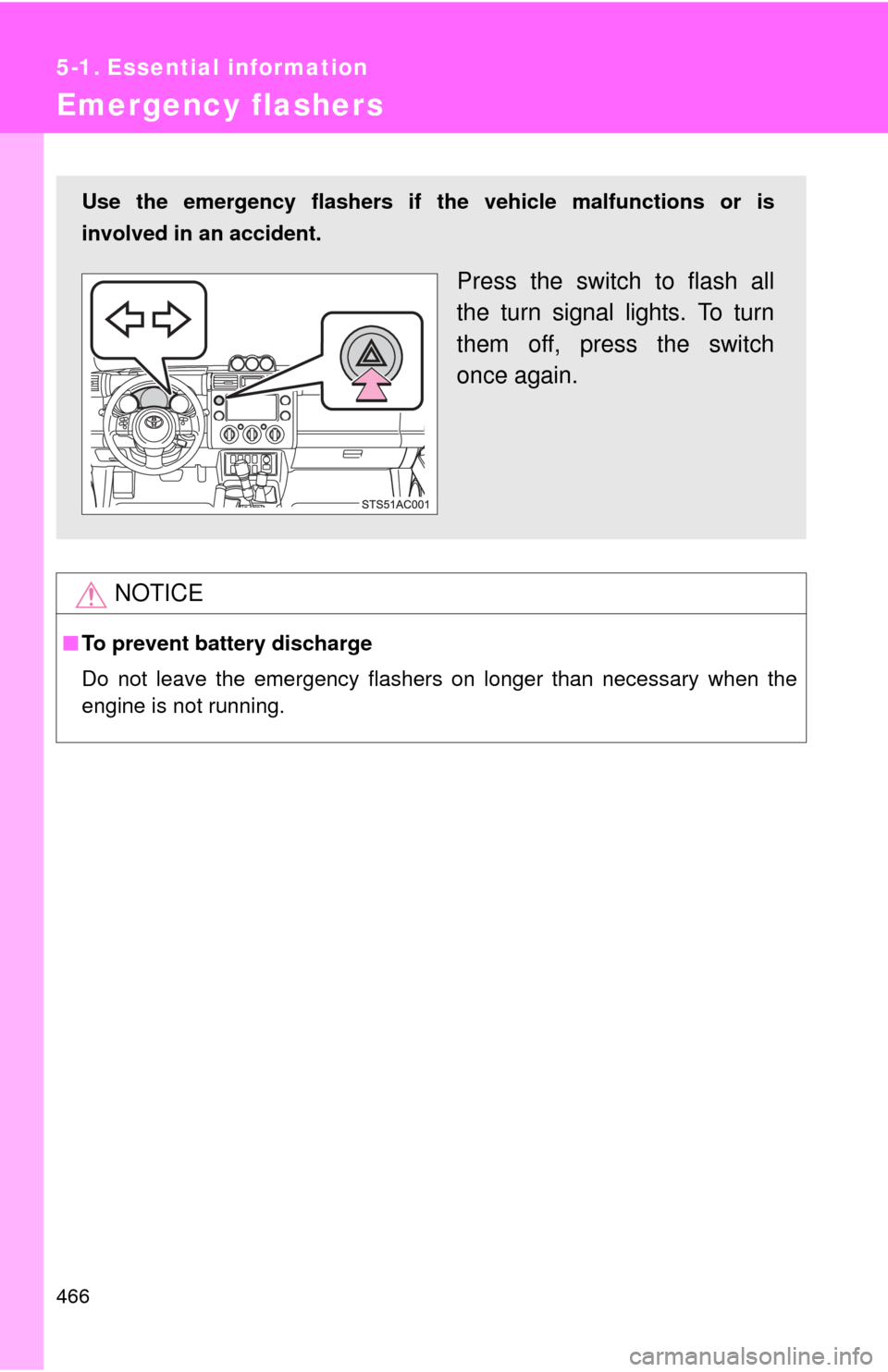
466
5-1. Essential information
Emergency flashers
NOTICE
■To prevent battery discharge
Do not leave the emergency flashers on longer than necessary when the
engine is not running.
Use the emergency flashers if th e vehicle malfunctions or is
involved in an accident.
Press the switch to flash all
the turn signal lights. To turn
them off, press the switch
once again.
Page 467 of 572
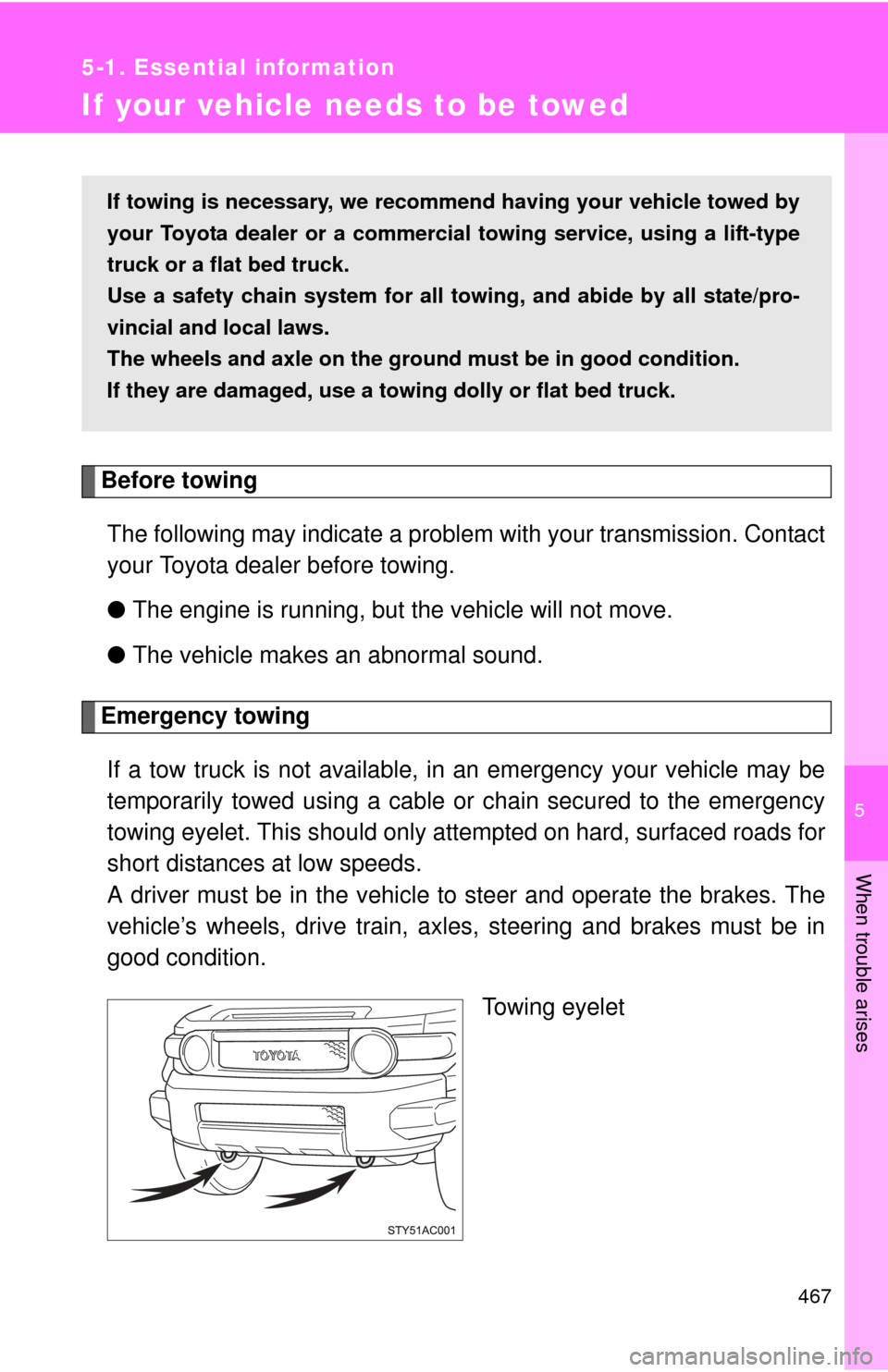
5
When trouble arises
467
5-1. Essential information
If your vehicle needs to be towed
Before towingThe following may indicate a problem with your transmission. Contact
your Toyota dealer before towing.
● The engine is running, but the vehicle will not move.
● The vehicle makes an abnormal sound.
Emergency towing
If a tow truck is not available, in an emergency your vehicle may be
temporarily towed using a cable or chain secured to the emergency
towing eyelet. This should only attempted on hard, surfaced roads for
short distances at low speeds.
A driver must be in the vehicle to steer and operate the brakes. The
vehicle’s wheels, drive train, axles, steering and brakes must be in
good condition.
Towing eyelet
If towing is necessary, we recommend having your vehicle towed by
your Toyota dealer or a commerci al towing service, using a lift-type
truck or a flat bed truck.
Use a safety chain system for all to wing, and abide by all state/pro-
vincial and local laws.
The wheels and axle on the groun d must be in good condition.
If they are damaged, use a towing dolly or flat bed truck.
Page 468 of 572
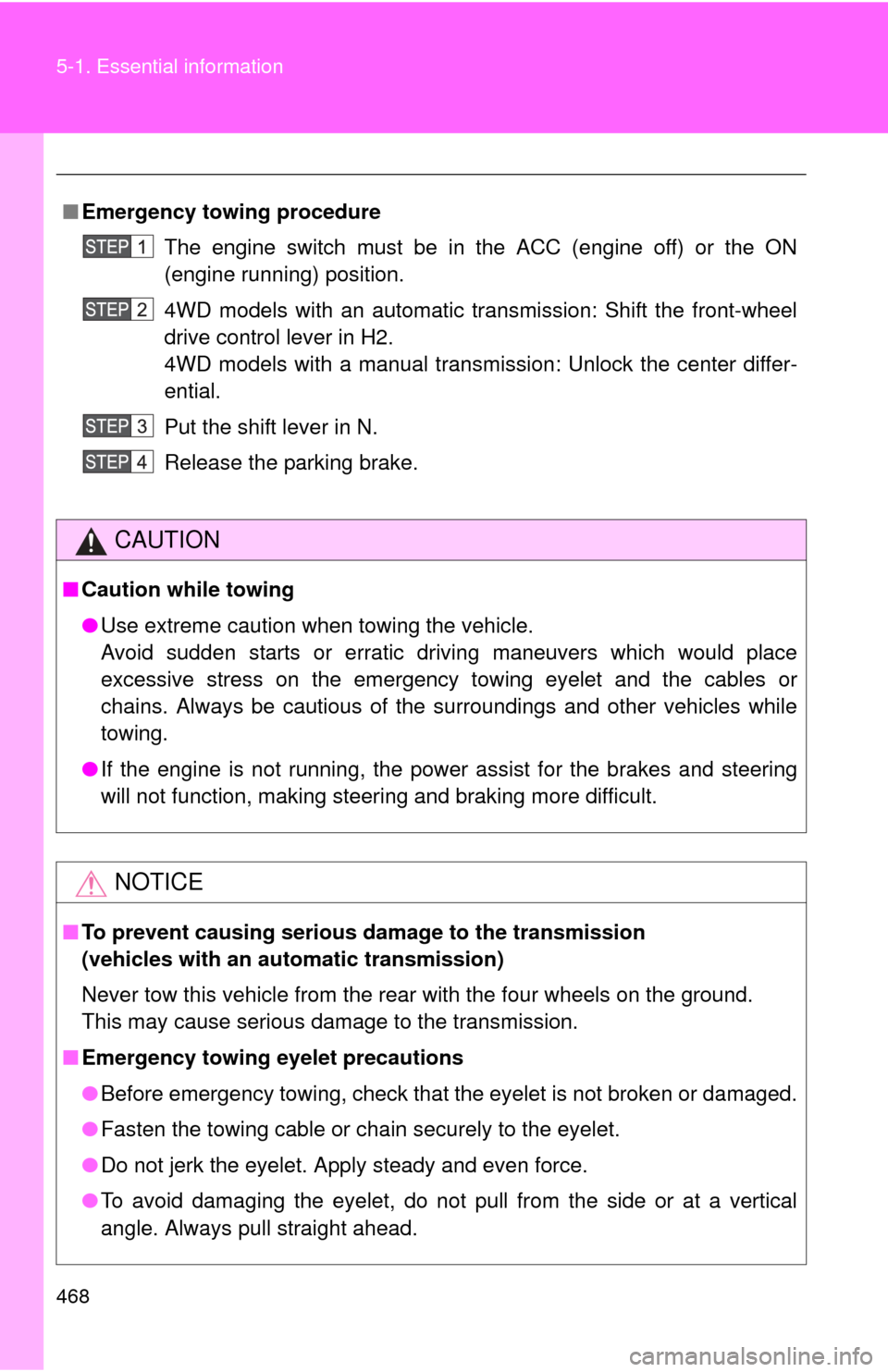
468 5-1. Essential information
■Emergency towin g procedure
The engine switch must be in the ACC (engine off) or the ON
(engine running) position.
4WD models with an automatic transmission: Shift the front-wheel
drive control lever in H2.
4WD models with a manual transmission: Unlock the center differ-
ential.
Put the shift lever in N.
Release the parking brake.
CAUTION
■ Caution while towing
●Use extreme caution when towing the vehicle.
Avoid sudden starts or erratic driving maneuvers which would place
excessive stress on the emergency towing eyelet and the cables or
chains. Always be cautious of the surroundings and other vehicles while
towing.
● If the engine is not running, the power assist for the brakes and steering
will not function, making steering and braking more difficult.
NOTICE
■To prevent causing serious dama ge to the transmission
(vehicles with an automatic transmission)
Never tow this vehicle from the rear with the four wheels on the ground.
This may cause serious damage to the transmission.
■ Emergency towing eyelet precautions
● Before emergency towing, check that the eyelet is not broken or damaged.
● Fasten the towing cable or chain securely to the eyelet.
● Do not jerk the eyelet. Apply steady and even force.
● To avoid damaging the eyelet, do not pull from the side or at a vertical
angle. Always pull straight ahead.